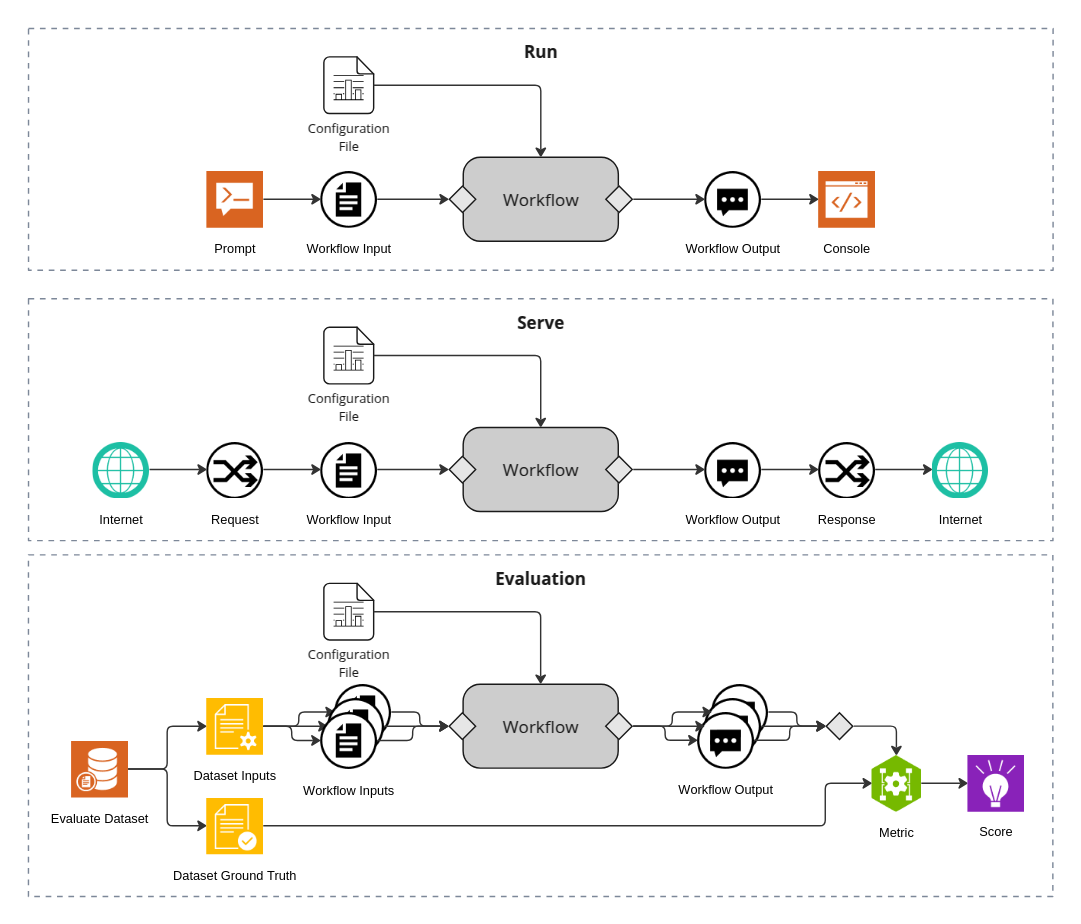Run NVIDIA NeMo Agent Toolkit Workflows#
A workflow is defined by a YAML configuration file that specifies the tools and models to use. NeMo Agent toolkit provides the following ways to run a workflow:
Using the
nat runcommand.This is the simplest and most common way to run a workflow.
Using the
nat servecommand.This starts a web server that listens for incoming requests and runs the specified workflow.
Using the
nat evalcommand.In addition to running the workflow, it also evaluates the accuracy of the workflow.
Using the Python API
This is the most flexible way to run a workflow.

Prerequisites#
Ensure that you have followed the instructions in the Install Guide to create the development environment and install NeMo Agent toolkit.
The examples in this document utilize the examples/getting_started/simple_web_query workflow, install it by running the following commands from the root directory of the NeMo Agent toolkit library:
uv pip install -e examples/getting_started/simple_web_query
Set Up API Keys#
If you have not already done so, follow the Obtaining API Keys instructions to obtain an NVIDIA API key. You need to set your NVIDIA API key as an environment variable to access NVIDIA AI services:
export NVIDIA_API_KEY=<YOUR_API_KEY>
Using the nat run Command#
The nat run command is the simplest way to run a workflow. nat run receives a configuration file as specified by the --config_file flag, along with input that can be specified either directly with the --input flag or by providing a file path with the --input_file flag.
A typical invocation of the nat run command follows this pattern:
nat run --config_file <path/to/config.yml> [--input "question?" | --input_file <path/to/input.txt>]
The following command runs the examples/getting_started/simple_web_query workflow with a single input question “What is LangSmith?”:
nat run --config_file examples/getting_started/simple_web_query/configs/config.yml --input "What is LangSmith?"
The following command runs the same workflow with the input question provided in a file:
echo "What is LangSmith?" > .tmp/input.txt
nat run --config_file examples/getting_started/simple_web_query/configs/config.yml --input_file .tmp/input.txt
Using the nat eval Command#
The nat eval command is similar to the nat run command. However, in addition to running the workflow, it also evaluates the accuracy of the workflow, refer to Evaluating NeMo Agent toolkit Workflows for more information.
Using the nat serve Command#
The nat serve command starts a web server that listens for incoming requests and runs the specified workflow. The server can be accessed with a web browser or by sending a POST request to the server’s endpoint. Similar to the nat run command, the nat serve command requires a configuration file specified by the --config_file flag.
The following command runs the examples/getting_started/simple_web_query workflow on a web server listening to the default port 8000 and default endpoint of /generate:
nat serve --config_file examples/getting_started/simple_web_query/configs/config.yml
In a separate terminal, run the following command to send a POST request to the server:
curl --request POST \
--url http://localhost:8000/generate \
--header 'Content-Type: application/json' \
--data '{
"input_message": "What is LangSmith?"
}'
Refer to nat serve --help for more information on how to customize the server.
Using the Python API#
The toolkit offers a programmatic way to execute workflows through its Python API, allowing you to integrate workflow execution directly into your Python code. Here’s how to use it:
import asyncio
from nat.runtime.loader import load_workflow
from nat.utils.type_utils import StrPath
async def run_workflow(config_file: StrPath, input_str: str) -> str:
async with load_workflow(config_file) as workflow:
async with workflow.run(input_str) as runner:
return await runner.result(to_type=str)
result = asyncio.run(
run_workflow(config_file='examples/getting_started/simple_web_query/configs/config.yml',
input_str='What is LangSmith?'))
print(result)
In this example:
config_file: A string orPathpointing to your workflow YAML fileinput_str: A string containing the input for your workflowThe
workflow.run(input_str)method returns an instance ofRunner
For detailed information about the Runner class and its capabilities, please refer to the Python API documentation for the Runner class.